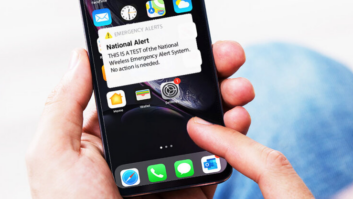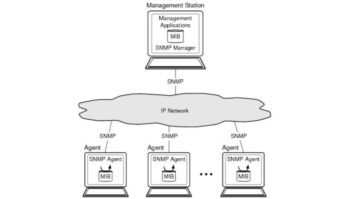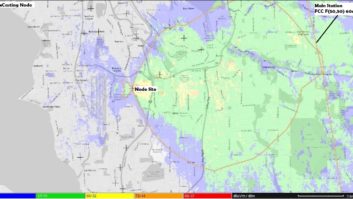LAS VEGAS Companies at this winter’s Consumer Electronics Show featured gadgets to help drivers get around more easily, access their music databases and give voice commands in car models that will come out this year. Some versions of these products include radio features.
Another trend: More in-dash receiver manufacturers are dropping CDs in favor of a connection for an iPod or other media device.
Radio has more competition coming from programming delivered on small screens.
Mobile DTV was demoed on devices coming to market this year, including laptops, netbooks and cell phones. Similarly, there were lots of Internet-connected TV sets — enabling direct hookup from a TV set into the growing array of online video services. And for consumers who don’t want to buy a new Web-equipped HDTV set, there are services that you can hook up to your TV set to see those Internet video streams. Manufacturers showed 3D TV prototypes.
Possibly the biggest story for radio coming out of CES is the progress Internet radio is making toward parity with traditional radio’s penetration not only in the home but in the car.
Pandora Internet Radio, for example, is making gains in the automobile through deals with Ford, Alpine and Pioneer, giving drivers another non-broadcast entertainment option. “We’re about bringing personalization to radio. We’re about being anytime and anywhere,” said Chief Executive Officer Joe Kennedy during a session on connectivity in the car.
“In the future every car will have an embedded Internet connection,” he predicted.
A radio programmer at CES who tracks where eyes and ears will be years from now summed up the Pandora announcements as “bad news for radio stations.” Radio is not just a distribution service that happens to have an aux transmitter, he told Radio World, noting the substantial investment broadcasters have made in their transmission systems.
Here are some of the more notable devices coming on the market as seen at CES. Look for digital radio product news from CES in our next digital radio section.
Myine’s Abbee Strips Out Spots, DJs
A new FM tuner promises to strip out commercials and DJ talk from FM content; the developer of the underlying technology says it could be adapted to any kind of media player that contains a radio. The user then enjoys full access to the stored songs, including playback, fast forward and rewind functions.
Might this be the first system to gain market traction that does for radio what TiVo did in TV, letting consumers record and save only those parts of a station’s programming that they want to hear?
Jake Sigal, the founder and CEO behind Myine Electronics, said he designed his commercial-free FM radio with his parents in mind. They don’t want to use one of his old iPods, for example, because they don’t want to go through the process of connecting the devices to a computer, downloading music and creating a playlist to hear the music.
Myine’s Abbee model AB001 promises to remove the commercials and DJ talk for hours of uninterrupted music.
Sigal said when you tune to a station, Abbee’s FM tuner records the audio stream, and, using the Popcatcher detection algorithm, analyzes the audio and removes the spots and DJ patter. The individual songs are saved as MP3 files and stored on the docked Music Lock portable player for playback over the built-in speakers or elsewhere. The player has a 500 song capacity or 2 GB of storage space, according to the company.
Myine also worked with the National Federation for the Blind to make the portable player accessible. Buttons for skip, pause, play, fast-forward, as well as save and delete command are raised and are different shapes.
The Abbee commercial-free music system is shipping and available from Myine and Amazon. It lists for $249.99.
Sweden-based Popcatcher says its technology “can be integrated with almost every kind of media player that contains a radio.” It’s pursuing deals to integrate its technology in cell phones, portable MP3 players and car stereos. Popcatcher says it can detect repeat songs and skip those, too.
Ford, Pandora Meet in the Dash

This view of the MyFord Touch shows the display on the right side of the steering wheel, an MP3 player-originated song. Ford is integrating Pandora, the “personalized Internet music service,” into its Sync platform using Bluetooth connectivity. The automaker updated its Sync communications platform, which allows for hands-free use of the cell phone, radio and music from other sources using controls on the wheel or in the center console.
“Four-point-one billion texts were sent per day in 2009. In Ford vehicles, listening to a text is no different than listening to the radio,” said Doug VanDagens, director of Ford Connected Service Solutions, during a keynote speech.
The automaker wanted to incorporate entertainment features into the car, rather than use a bolt-on approach, spokesman Charles Zinkowski said in an interview.
The updated Sync — which controls the user’s phone, navigation, entertainment and climate using the MyFord Touch user interface — will be available on some 2011 Fords and Lincolns using MyLincoln Touch later this year.
Sync will stream audio over Bluetooth and control the application on a cell phone using vehicle controls, application engineer Joe Ross said. Users can use voice commands or the buttons in the center stack to make or receive a call, play music from a CD or MP3 player or listen to the radio, in addition to listening to Internet radio through Pandora.
The iPhone connected to the vehicle via USB port is controlling the Pandora service and other choices; the driver uses the big screen in the center console or two somewhat smaller screens on either side of the steering wheel. To use Pandora, drivers choose “Mobile Applications” from the menu. It displays song, title and artist. The user can listen to the current song, skip to another track using voice commands or continue deeper into the menu until hearing an audio confirmation of the choice.
Asked how the driver can be sure there’s enough bandwidth in a particular area to use Pandora in a moving vehicle, Ross said Pandora varies the bitrate based on connection speed, and that’s controlled by the user’s phone.
To listen to talk Internet radio content, the driver would need to use the Stitcher application.
AM/FM radio is still part of the entertainment choices in Fords, and RDS messages can be displayed. HD Radio is being added to Sync this calendar year for 2011 model vehicles (more coverage in our next issue).
Pioneer Adds Pandora Capability to Nav System

The Pioneer touch-screen AVIC-X920BT navigation system will detect iPhones and iPod touches that have Pandora installed and put the consumer’s Pandora settings on the screen so drivers can hear their favorite channels. Starting this spring, Pioneer will sell a navigation and entertainment device that allows Pandora users who stream the service on their iPhones to access the Internet music service in their cars.
The touch-screen AVIC-X920BT navigation system will detect iPhones and iPod touches that have Pandora installed and put the consumer’s Pandora settings on the navigation screen so drivers can hear Pandora channels.
In an interview with Radio World, Pioneer Corporate Communications Manager Jaed Arzadon said Pioneer is actually providing a Pandora link by supplying a cable with an iPhone connector on it to use with the in-dash unit. “The link enables you to get everything Pandora is doing within an iPhone device — and now you’re getting that on a larger screen on the dash.”
Using Pioneer’s navigation system with Pandora will require an application that users will download onto their iPhones.
In addition to built-in navigation capabilities, the AVIC-X920BT features 4 GB of flash memory, a large 6.1-inch WVGA touch screen display, a 3D graphics accelerator, DVD playback, built-in Bluetooth for hands-free calling and music streaming, USB connectivity for iPod/iPhone connectivity, micro SD card slot and back-up camera input. It is compatible with Pioneer satellite and HD Radio tuners.
The AVIC-X920BT navigation system will ship to retailers in March/April and cost about $1,200.
Alpine Too, Gets to Know Pandora
Apple iPhone users who are also Pandora fans will be able to get a taste of Internet radio during their commutes when the Alpine iDA-X305S is released this spring. Alpine Electronics has added Pandora Internet radio support, but omitted a CD drive, in the new iDA-X305S car stereo. The company says the unit is optimized for users who keep their music libraries on an iPod or iPhone.
The iDA-X305S is able to control the Pandora app on a connected iPhone 3G or 3GS, streaming user-created radio stations over a 3G data connection and out of the vehicle’s speakers.
Its high-resolution 2.2-inch color TFT screen is used to display audio source information. The unit has a double-action encoder knob that is used for volume control plus iPod or iPhone music file access as well as viewing album artwork and tracking metadata, changing stations, skipping tracks, giving a song the thumbs up and down and bookmarking songs.
Optional tuners are available to add HD Radio reception with iTunes Tagging support or satellite radio services.
Alpine has a suggested price of $400 for the iDA-X305S.
Pure Introduces 5 FM/Internet Radios
U.K. radio designer Pure is introducing five Internet radios to the North American market. They should be available later this year, according to spokeswoman Vicky Deacon.

The Sensia units feature a large color touchscreen. Users can listen to streamed content when within range of a Wi-Fi network. For the U.K., Pure designed Internet and DAB radios; the U.S. devices will include FM analog and Internet radio.
The Sensia units feature a large high-resolution color touchscreen. Stereo sound plus an input for iPod/MP3 players and access to applications such as Facebook and Twitter offer consumers the ability to access and control their digital content from a central interface. Users can listen to streamed content anywhere within range of a Wi-Fi network.
Partnered with its elliptical shape in four color options — red, yellow, black and white — is a tilting stand and remote control. Users may also take the unit off the stand and use it in their laps, much like a laptop keyboard, Deacon noted.
The product will list for $349. Favorites and settings can be saved using the Pure Lounge media portal.
The company describes Evoke Flow as a kitchen radio. The wireless portable unit features FM with RBDS. The company says the unit, to list for $229, gives consumers access to digital content from almost anywhere.
The bedside Internet and FM radio Siesta Flow features touch-sensitive controls, up to 365 alarm settings and a USB PowerPort, which provides power for USB accessories. A Wi-Fi connection lets you listen to Internet radio, podcasts and Pure sounds or stream music from a computer. Siesta Flow will list for $139. In its booth, Pure showed this radio on a nightstand beside a tiny bed display.

Pure says the aluminum surround and rubberized seal of the Oasis Flow offers the user Internet connectivity with portability. For those who want to take their radio camping or to a picnic, the aluminum surround and rubberized seal of the Oasis Flow combines Internet connectivity with portability. The rechargeable Internet and FM radio will list for $249.
Pure describes the Sirocco as a micro-sized home hi-fi shelf unit that combines access to Internet content with the ability to play digital music from portable iPod and iPhone devices, USB memory drives, SD memory cards and CDs. The Sirocco will list for $449.
Livio Showcases Pandora, NPR-Branded Internet Radios
Livio says it tries to make Internet audio streams accessible to more people in more places by designing audio products that work fast without complicated menus.
The company showcased its Livio Radio, designed to let users listen to Pandora Internet radio in the home “without a Ph.D. in consumer electronics,” according to CEO Jake Sigal.
The Livio Radio, which offer Pandora’s “thumbs up, thumbs down” controls on the front panel and via remote, helps users customize the music and programming they receive.
If you have a power source and a Web connection, the unit connects quickly and plays some 11,000 Internet radio stations through its own speaker, without needing access to a computer interface to operate, according to the maker. The Livio Radio lists for $199.99 at the company’s Web site (where in late January the unit was listed as sold out).
The new NPR Radio by Livio, the first branded NPR consumer electronics device, is an Internet radio that features NPR stations, programs and content in a special NPR menu. The menu allows users to search, find and bookmark their NPR stations, podcasts and content, by topic or by program. In addition to approximately 800 NPR stations, the unit features the Reciva database of Internet stations and receives an additional 16,000 Internet streams.
While the user does not need to have a computer to use the NPR Radio by Livio, he or she must have an Internet connection with a wireless router (or an available Ethernet port for a wired connection).
Livio also plans to add a branded AARP radio to its lineup.
GSS, Silicon Labs Work to Get FM Alerts in CE Devices

GSS sells the Alert FM system, which delivers alerts using FM RBDS, SMS (text) and e-mail. GSS is working with other companies to get FM chips in cellphones and other devices for alerting purposes. Global Security Systems and its partner Silicon Labs are speaking with consumer electronics manufacturers and wireless companies about alerting. We’ve reported that the Federal Emergency Management Agency is moving forward with implementation of public alert via broadcasters as well as devices such as cell phones.
GSS Executive Vice President Matthew Straeb heads a Consumer Electronics Association working group addressing implementation of Common Alerting Protocol-based alerts among consumer electronics devices that process CAP-encoded data, independent of delivery method — whether consumers receive the alerts from a broadcast station, over the Internet from their computer or via their cellphone or other CE device that contains an FM chip.
Wireless carriers are also a part of the CEA’s “R6 WG16” working group, though another working group is focusing on cellphone alerting as well.
The group that’s working on fixed and mobile alert warning devices comprises cell carriers, TV set manufacturers, weather radio, broadcasters, data service providers and receiver manufacturers.
“We’re providing a road map for companies that want to provide alerting capability, but don’t know what to do,” Straeb said in an interview on the show floor. Members are looking at the behavior of the alert, how it would be displayed and the interaction of that alert with other features of the device.
“We want commonality, which leads to more consumer adoption.”
Straeb and Silicon Labs Marketing Director Wade Gillham noted that FM radio chips in cellphones, for example, are capable of receiving audio EAS messages with FM-based data alert messages. The committee’s work would incorporate FM RBDS. “The reason having cell phones that incorporate an FM receiver is now you’d have a ubiquitous point-to-many multi-points for a proactive alert,” said Gillham.
SiLabs makes FM chips. GSS sells the Alert FM system, which delivers alerts using FM RBDS, SMS (text) and e-mail.
Slacker Radio Showcases Mobile Capabilities
Slacker Radio, another competitor in the online “personalized radio” game, demonstrated new mobile capabilities including station caching for a range of devices that will enable listeners to get the Slacker experience without a network connection. Slacker also showed a new Slacker app for the Palm Pre and Palm Pixi, in addition to announcing plans to integrate ABC News into the Slacker Personal Radio offering.
Slacker Personal Radio enables listeners to create personal radio stations based on any artist or mix of artists, or listen to and personalize 120 “expert-programmed” genre stations.
The company said the wireless station caching capability will enable iPhone, iPod touch, Android and BlackBerry smartphone users to save their favorite Slacker stations, storing the music on the device or SD memory Card, to listen anywhere whether they are connected to a wireless network or not.
Fraunhofer Shows Consumer Hardware Using HD-AAC
Fraunhofer introduced consumer hardware using its lossless HD-AAC codec, the Logitech Squeezebox Touch, available for $199.99. This enables consumers to download or rip one file that will play on existing AAC devices, such as most mobile phones and all iPods, and also playback “losslessly” through their living room stereo using the Squeezebox Touch connected to their PC or the Internet.
Fraunhofer says its new MPEG HD-AAC codec offers music quality superior to the CD and compatibility with iPods and AAC-enabled mobile phones. Based on the MPEG-4 SLS and AAC-LC standards, Fraunhofer’s HD-AAC provides lossless compression of 16/24-bit and up to 192 kHz quality music content.
The company also demoed MPEG Surround, a new standard delivering iPod-compatible surround sound at stereo bitrates. Attendees experienced MPEG Surround from a legacy iPod through a Fraunhofer-designed iPod docking station prototype.
Also of Interest
— Audiovox added Pandora to its next generation of Wi-Fi-equipped tabletop Internet radios. They also feature Slacker Radio, Weatherbug and MP3 tunes services, as well as access to individual Internet stations.
— The first Internet radio from iLive is the iRP800B, a tabletop model with no AM/FM. It includes an iPod/iPhone dock on the top, enbedded Wi-Fi and Ethernet port. The unit lists for $149.
— Audiovox says the XMp3i is the smallest portable satellite radio and MP3 player in the Sirius XM line. The device records up to 100 hours of live XM programming including 10 hours of songs, and gives users the ability to pause, rewind and replay up to 30 minutes of satellite radio. With an optional kit, users can enjoy satellite radio through a vehicle’s FM radio. XMp3i will list for $229.95.
— The Bluetooth Special Interest Group chose apt-X Creative Inspire S2 Wireless Speakers as the winner of its 5th Annual Best of CES 2010 Awards, an event to highlight Bluetooth-enabled products. The group said the products exemplified functionality, innovative design and a user-friendly experience.
— CEA had been estimating 110,000 attendance prior to the show, compared to 113,000 from 2009. However CEA President/CEO Gary Shapiro said total attendance was more than 120,000.







